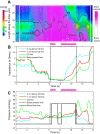Flow time through esophagogastric junction derived during high-resolution impedance-manometry studies: a novel parameter for assessing esophageal bolus transit
- PMID: 24852565
- PMCID: PMC4101677
- DOI: 10.1152/ajpgi.00119.2014
Flow time through esophagogastric junction derived during high-resolution impedance-manometry studies: a novel parameter for assessing esophageal bolus transit
Abstract
This study aimed to develop and validate a method to measure bolus flow time (BFT) through the esophagogastric junction (EGJ) using a high-resolution impedance-manometry (HRIM) sleeve. Ten healthy subjects were studied with concurrent HRIM and videofluoroscopy; another 15 controls were studied with HRIM alone. HRIM studies were performed using a 4.2-mm-outer diameter assembly with 36 pressure sensors at 1-cm intervals and 18 impedance segments at 2-cm intervals (Given Imaging, Los Angeles, CA). HRIM and fluoroscopic data from four barium swallows, two in the supine and two in the upright position, were analyzed to create a customized MATLAB program to calculate BFT using a HRIM sleeve comprising three sensors positioned at the crural diaphragm. Bolus transit through the EGJ measured during blinded review of fluoroscopy was almost identical to BFT calculated with the HRIM sleeve, with the nadir impedance deflection point used as the signature of bolus presence. Good correlation existed between videofluoroscopy for measurement of upper sphincter relaxation to beginning of flow [R = 0.97, P < 0.001 (supine) and R = 0.77, P < 0.01 (upright)] and time to end of flow [R = 0.95, P < 0.001 (supine) and R = 0.82, P < 0.01 (upright)]. The medians and interquartile ranges (IQR) of flow time though the EGJ in 15 healthy subjects calculated using the virtual sleeve were 3.5 s (IQR 2.3-3.9 s) in the supine position and 3.2 s (IQR 2.3-3.6 s) in the upright position. BFT is a new metric that provides important information about bolus transit through the EGJ. An assessment of BFT will determine when the EGJ is open and will also provide a useful method to accurately assess trans-EGJ pressure gradients during flow.
Keywords: bolus transit; impedance; manometry.
Copyright © 2014 the American Physiological Society.
Figures


References
-
- Dodds WJ. 1976 Walter B. Cannon Lecture: current concepts of esophageal motor function: clinical implications for radiology. Am J Roentgenol 128: 549–561, 1977 - PubMed
-
- Fass J, Silny J, Braun J, Heindrichs U, Dreuw B, Schumpelick V, Rau G. Measuring esophageal motility with a new intraluminal impedance device. First clinical results in reflux patients. Scand J Gastroenterol 29: 693–702, 1994 - PubMed
-
- Ghosh SK, Kahrilas PJ, Lodhia N, Pandolfino JE. Utilizing intraluminal pressure differences to predict esophageal bolus flow dynamics. Am J Physiol Gastrointest Liver Physiol 293: G1023–G1028, 2007 - PubMed
-
- Imam H, Marrero F, Shay S. Impedance nadir values correlate with barium bolus amount. Dis Esophagus 25: 600–607, 2012 - PubMed
Publication types
MeSH terms
Substances
Grants and funding
LinkOut - more resources
Full Text Sources
Other Literature Sources
Medical

